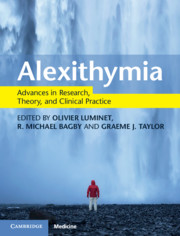Book contents
- Alexithymia
- Alexithymia
- Copyright page
- Dedication
- Contents
- Contributors
- Foreword
- Preface
- Acknowledgements
- Part I History, Assessment, and Cultural Shaping of Alexithymia
- Part II Emotion and Cognitive Processing
- Part III Clinical Issues and Somatic and Psychiatric Pathology
- Chapter 7 Alexithymia and Physical Illness: A Psychosomatic Approach
- Chapter 8 Attachment, Trauma, and Alexithymia
- Chapter 9 Relations between Alexithymia and Depressive and Anxiety Disorders and Personality
- Chapter 10 Alexithymia and Maladaptive Regulatory Behaviors in Substance Use Disorders and Eating Disorders
- Chapter 11 Social and Interpersonal Implications of Alexithymia
- Chapter 12 Therapeutic Issues
- Part IV Biological Considerations
- Part V Concluding Remarks
- Index
- References
Chapter 11 - Social and Interpersonal Implications of Alexithymia
from Part III - Clinical Issues and Somatic and Psychiatric Pathology
Published online by Cambridge University Press: 07 September 2018
- Alexithymia
- Alexithymia
- Copyright page
- Dedication
- Contents
- Contributors
- Foreword
- Preface
- Acknowledgements
- Part I History, Assessment, and Cultural Shaping of Alexithymia
- Part II Emotion and Cognitive Processing
- Part III Clinical Issues and Somatic and Psychiatric Pathology
- Chapter 7 Alexithymia and Physical Illness: A Psychosomatic Approach
- Chapter 8 Attachment, Trauma, and Alexithymia
- Chapter 9 Relations between Alexithymia and Depressive and Anxiety Disorders and Personality
- Chapter 10 Alexithymia and Maladaptive Regulatory Behaviors in Substance Use Disorders and Eating Disorders
- Chapter 11 Social and Interpersonal Implications of Alexithymia
- Chapter 12 Therapeutic Issues
- Part IV Biological Considerations
- Part V Concluding Remarks
- Index
- References
- Type
- Chapter
- Information
- AlexithymiaAdvances in Research, Theory, and Clinical Practice, pp. 174 - 189Publisher: Cambridge University PressPrint publication year: 2018
References
- 10
- Cited by

